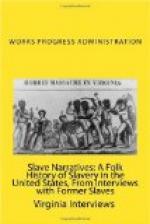“We made our own maple syrup from the maple sugar trees. This is a lot better than the refined sugar people have nowdays, and is good for you too. You can’t get this now though, except sometimes and it is awfully high priced. On the plantations the slaves usually had a house of their own for their families. They usually built their houses in a circle, so you didn’t have to go out doors hardly to go to the house next to you. If you wanted your house away from the rest of the houses, they could build you a house away from the others and separate.”
I was never sold, I always had just my one master. When slave owners died, if they had no near relatives to inherit their property, they would ‘Will’ the slaves their freedom, instead of giving them to someone else. My grandmother, and my mother were both freed like this, but what they called ‘nigger traders’ captured them, and two or three others, and they took them just like they would animals, and sold them, that was how ‘Ples’ Holbert got my mother. My grandmother was sent to Texas. My mother said she wrote and had one letter from my grandmother after that, but she never saw her again.”
“My mother used to be a cook, and when she was busy cooking, my mistress would nurse both me and her baby, who was four weeks older than me. If it happened the other way around, my mother would nurse both of us. They didn’t think anything about it. When the old people died, and they left small orphan children, the slaves would raise the children. My young master was raised like this, he has written to me several times, since I have been out here in Kansas, but the last time I wrote, I have had no reply, so I suppose he was dead.”
“When anyone died, they used to bury the body at least six feet under the ground. There wasn’t such a thing as a cemetery then, they were just buried right on the plantation, usually close to the house. They would put the body in a wagon, and walk to where to bury the person, and they would sing all of the way.”
“The slaves used to dance or go to the prayer meeting to pass their time. There were also festivals we went to, during the Christmas vacation. There was always a big celebration on Christmas. We worked until Christmas Eve and from that time until New Year’s we had a vacation. We had no such thing as Thanksgiving, we had never heard of such a thing.”
“In August when it was the hottest we always had a vacation after our crops were all laid by. That was the time when we usually had several picnics, barbecues or anything we wanted to do to pass our time away.”




